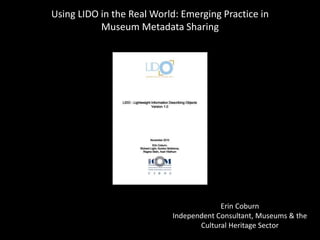LIDO - MCN Annual Conference 2014
- 1. Using LIDO in the Real World: Emerging Practice in Museum Metadata Sharing Erin Coburn Independent Consultant, Museums & the Cultural Heritage Sector
- 2. An XML schema for delivering metadata to a variety of online services in a standardized way
- 3. WHY LIDO
- 4. ORIGINS
- 6. SCOPE XML schema for delivering metadata to a variety of online services, from an organization’s online collections database to portals of aggregated resources – as well as exposing, sharing and connecting data on the web. Intended to represent the full range of descriptive information about museum objects, e.g. art, cultural, technology and natural science. Supports multilingual environments.
- 7. Individual data providers can decide on how light – or how rich – they want their contributed metadata records to be. Allows for delivering data and resources / digital surrogates relating to your objects. Includes links from contributed metadata back to records in their 'home' context
- 8. Allows for identification of each referenced entity, e.g. provide references to controlled vocabulary and authority files. Provides optimized metadata for retrieval, and for display – distinction of display and indexing elements.
- 9. Descriptive and administrative information groups in LIDO -Events – Event Set -Relations – Subject Set Related Works -Administrative Metadata – Rights Record (mandatory) Resource - Object Classifications – Object / Work Type (mandatory) Classification -Object Identifications – Title / Name (mandatory) Inscriptions Repository / Location State / Edition Object Description Measurements









